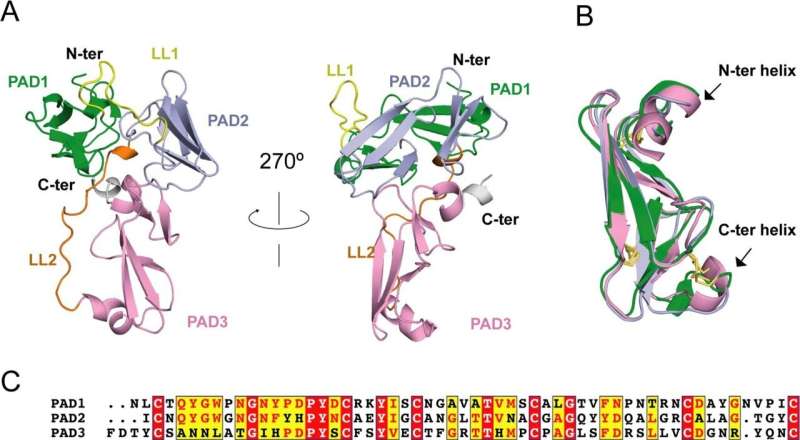This article has been reviewed according to Science X's editorial process and policies. Editors have highlighted the following attributes while ensuring the content's credibility:
fact-checked
peer-reviewed publication
trusted source
proofread
Predator-prey defense mechanisms could unlock key to marine biofuel production

Researchers have unpicked the mechanism behind a marine feeding strategy that could provide a valuable renewable source of biofuel.
Their research has been published as a Reviewed Preprint in eLife, with the revised version appearing today. It is described by the editors as an important study providing convincing evidence on how the sea slug Aplysia kurodai optimizes its digestion of brown algae, in a classical predator-prey 'arms race' at the molecular level. The authors' findings are supported by experimental protein structures and enzyme assays and hold promise for biotechnological applications in biofuel production.
Over millions of years, predators have successfully co-evolved with their prey to maintain an ecological balance. In marine habitats, interactions between algae and marine herbivores dominate marine ecosystems, with most algae being consumed by herbivores.
The feeding strategy of the sea slug Aplysia kurodai has attracted attention because when it feeds on brown algae, it converts a carbohydrate called laminarin to glucose, which could be used as a renewable fuel source. However, to protect themselves from sea slugs and other herbivores, the brown algae produce a secondary metabolite called phlorotannin that blocks this digestion, hindering the potential application of brown algae as feedstocks for biofuel.
"The enzyme responsible for laminin breakdown in the sea slug is called akuBGL, and it is blocked by phlorotannin. To counteract this antipredator adaptation of the brown algae, herbivores produce a substance in their digestive system called EHEP that protects from phlorotannins," explains co-first author Xiaomei Sun, Postdoctor at the Faculty of Advanced Life Science, Hokkaido University, Japan. "Although this defense-antidefense strategy is known, the detailed molecular mechanism underlying it remains unclear."
"With our study, we sought to understand the mechanism of this process, to benefit the application of this brown alga feeding system to the biofuel industry," adds co-first author Yuxin Ye, Postdoctor at the Faculty of Advanced Life Science, Hokkaido University.
As it is challenging to isolate distinct chemicals from phlorotannins found in algae, the researchers used an analog called TNA to explore its interaction with the sea slug's akuBGL enzyme and EHEP protein. They used X-ray crystallography and computer simulations to determine the structure of EHEP, with and without TNA and akuBGL.
Then they used the akuBGL structure to construct models of the enzyme and simulated the binding of both normal substrate (laminarin carbohydrate) and TNA. By exploring the interaction of TNA and the akuBGL enzyme with and without EHEP, they were able to propose a molecular mechanism of phlorotannin inhibition of akuBGL and of how EHEP protects against this.
In the absence of EHEP, phlorotannin occupies the substrate-binding pocket within akuBGL, preventing laminarin from binding and stopping glucose production. When EHEP is present it competitively binds to phlorotannin, freeing up the akuBGL binding pocket for glucose metabolism to happen as normal.
"Our study presents the molecular mechanism of the digestive-defencive-offencive association between brown algae and its herbivore predator, the sea slug," concludes senior author Min Yao, Emeritus Professor at the Faculty of Advanced Life Science, Hokkaido University. "This provides a molecular basis for the biofuel industry applications of brown algae."
More information: Xiaomei Sun et al, Structural basis of EHEP-mediated offense against phlorotannin-induced defense from brown algae to protect akuBGL activity, eLife (2023). DOI: 10.7554/eLife.88939.2
Journal information: eLife
Provided by eLife





















